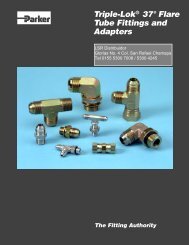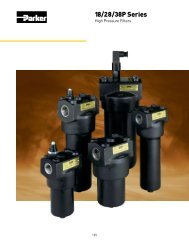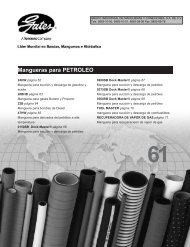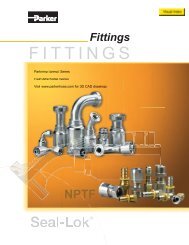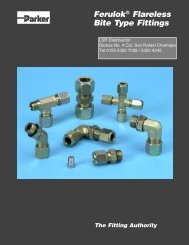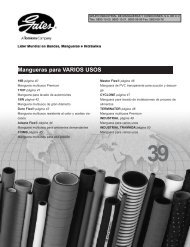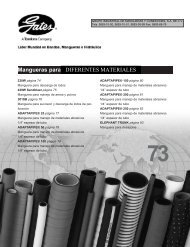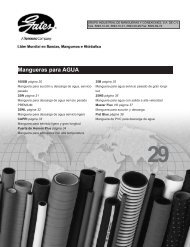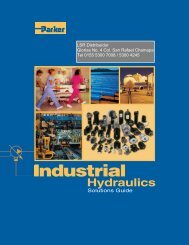Quick Coupling Products - LSR Distribuidor
Quick Coupling Products - LSR Distribuidor
Quick Coupling Products - LSR Distribuidor
- No tags were found...
You also want an ePaper? Increase the reach of your titles
YUMPU automatically turns print PDFs into web optimized ePapers that Google loves.
AppendicesGlossary of TermsAppendicesAir Inclusion: The ambient atmosphere forced into the systemduring the connection of the quick disconnect halves.Break-Away: Automatic disconnection of a coupling when anaxial separation force is applied.Brinelling: Dimples or grooves worn into the shoulder of amale half by the locking balls in the female half.Burst Pressure: The pressure at which a device loses thecapability to retain pressure.Case Hardening: Hardening the surface of low carbon steel..Cold Flow: Continued deformation under load.Connect Under Pressure: Ability to connect couplinghalves with internal line pressure applied to either both sidesor one side.<strong>Coupling</strong>, Female Half: Other nomenclature “coupler”,“socket”, “body”.<strong>Coupling</strong>, Male Half: Other nomenclature “nipple”,“plug”, “adapter”.<strong>Coupling</strong>, <strong>Quick</strong> Disconnect: A component which canquickly join or separate a fluid line without the use of tools orspecial devices.Differential Pressure (∆P): The difference in pressurebetween any two points of a system or a component.Double-Acting Sleeve: Permits push-to-connect and pull-todisconnectconvenience on implement line when female half isclamp mounted and connected with a hose.Dust Cap: Dust or dirt repelling enclosure for both halves.Dust Plug: Dust or dirt repelling enclosure both halves.Flow Checking: Occurs when a nipple valve closes duringflow conditions, such as when quickly lowering a heavyimplement. (Also called Check Off, Back Checking or Lock-up.)Flush Position (Valve): When the coupler valve is fully open,allowing maximum oil flow.Force to Connect: Axial and/or rotational force required tomake a complete connection.Force to Disconnect: The reverse of the above.Induction Hardening: Localized hardening of mediumcarbon steel.Peak Pressure: Maximum momentary pressure encounteredin the operation of a component.Pressure Cap: Cap which incorporates a seal capable ofwithstanding the rated pressures on the male half.Pressure Impulse Test: Subjecting a component to aspecified pressure at a specified rate of increase or decreasefor a specified time limit.Pressure Operating: The pressure at which a systemis operated.Pressure Plug: Plug which incorporates a seal capable ofwithstanding the rated pressures on the female half.Proof Pressure: The non-destructive test pressure in excessof the maximum rated operating pressure.Push To Connect (Auto Lock): Locking arrangement whichpermits one handed connection by pushing the nipple intothe coupler.Rated Pressure: The maximum pressure at which a product isdesigned to operate.Single-Acting Sleeve: Permits pull-to-disconnect convenienceon implement line when female body is clamp mounted.Making connection requires manually pulling female bodyforward, inserting male tip, then allowing body and tip to returnto original position in the clamp.Sleeve Lock: Arrangement which provides an additionallock which must be actuated before the locking sleeve canbe retracted.Spillage: The fluid removed from the system due todisconnection of a coupling assembly. This is the fluid trappedbetween the mating seal and the valve seal of the couplinghalves.Surge Pressure: The pressure existing from surge conditions.Surge Flows: A rapid increase in fluid flow.Thermal Build-Up: Hydraulic pressure caused byexpansion of the fluid due to heat from an external source suchas sunlight.Trapped Pressure: Pressurized hydraulic fluid trapped behindclosed coupling valveTwist Lock: A locking arrangement which requires a rotationalactuation to unlock the mating halves.Types of <strong>Quick</strong> Disconnect <strong>Coupling</strong> ValvesStraight-Thru (ST): This provides straight through flow.Double Shut-off Valve (DSO): A valve in the female half and avalve in the male half.Single Shut-off Valve (SSO): Generally, a valve in the femalehalf with no valve in the male half.NOTE: Refer to Parker’s Publication No. 3800-B1.0: Safety Guide for Selectingand Using <strong>Quick</strong> Action <strong>Coupling</strong>s and Related Accessories.IV-1Parker Hannifin Corporation<strong>Quick</strong> <strong>Coupling</strong> DivisionMinneapolis, MN 55427



